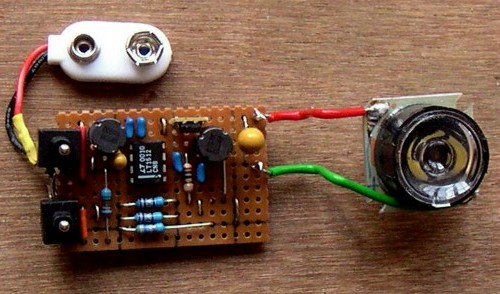

Introduction
Site list (GPS fixes) Walks (GPS tracks) Video clips Panoramas
Electronic projects:
Bat detector
Lamp tests
µ-controlled lamp
SEPIC-based lamp
ISP isolators
Making SMT boards
Expedition logs:
Spain 1973, 1974,
1975, 1976, 1977,
1979, 1982, 1983,
1985, 1986, 1987,
1988, 1989, 2000,
2001, 2002, 2003,
2004, 2005, 2006,
2007, 2008, 2009,
2010, 2011, 2012,
2013, 2014, 2015,
2016, 2017, 2018,
2019, 2020, 2021,
2022, 2023
Mexico
New England
Translation:
Luxeon LED caving lamps – LT1512 SEPIC solution
Speleogroup is experimenting with circuits for driving high-power LED devices, such as the White LED Luxeon Star from Lumileds ». This device is rated at approximately one watt, giving typically 18 lumens at its rated current of 350mA.
To use these devices safely at maximum power, and provide switchable power levels, it is best to use a constant-current circuit. To maximize battery life, we are investigating switched constant-current circuits using off-the-shelf power control ICs and microcontrollers.
This page describes one circuit we’ve developed, using the Linear Technology LT1512 chip, a current mode switching regulator. A later design uses the Atmel » ATtiny15L microcontroller.
LT1512 solution
The LT1512 chip, from Linear Technology » is a current mode switching regulator designed for controlling a battery charger. We disable the constant-voltage control loop and use its current sense input (nominally regulating 100mV across a sense resistor) to configure it as a constant current source.
The regulator topology used is SEPIC. This is not the most efficient topology (we get about 78% efficiency), but it is very flexible because it allows a wide range of input voltages (2.7V to 30V).
This means that many combinations of battery pack can be used, from 3-cell NiCd, NiMH, or Alkaline or one cell Li-Ion upwards, even though Luxeon Star LED typically has a forward voltage drop of 3.4V and the 3-cell configuration will have just 3V at the nominal end of discharge.
The parts are all available in SMT packages, which allows a very small layout, but we built the circuit using through-hole components so it could be tested on a breadboard and then built on stripboard:
In the picture, the Luxeon Star LED (with optics) is on the right. On the left are two miniature washable toggle switches; the upper is used as an on/off switch and the lower switch selects one of three power levels. When built into a case a four-position rotary switch would be a good choice for controlling the circuit.
The pale blue resistors (lower middle of the board) form, with the lower switch, the current selection circuit, as shown in the schematic. The three choices give the following currents and light times, tested using a battery pack of 4 x 2000mAh NiMH batteries:
| Resistance | Constant current | Light duration (hours) |
| 0.26 Ω | 348 mA | 5.6 |
| 0.60 Ω | 159 mA | 13.2 |
| 1.80 Ω | 54 mA | 38 (est.) |
The resistor values were chosen so that the light output at the lowest setting (approximately 50mA) would be roughly equivalent to a typical ‘key chain’ LED light such as the Photon Micro-light ». (We tested this light in El Cuevón de la Pruneda in June 2002 and found it was quite possible to navigate and exit the cave with this level of light.)
The highest setting (350mA) is the full current the LED is rated for, and the mid-level (160mA) was chosen to give a good light with significant power savings over the full output (at least 10 hours of light). Note that the current sense voltage will vary between LT1512 devices so some sense resistor tuning will generally be needed.
Please note: if you build this circuit, you do so at your own risk. Modern batteries can deliver considerable power, and a short-circuit can cause a risk of fire. Components can fail, too, and battery chargers may not fully charge batteries, so, as always when caving, carry at least one spare light per person sufficient to get you out of the cave.
Spice simulation
The circuit was first designed and simulated using the Linear LTC SwitcherCAD III » simulator from Linear Technology ».
The circuit definition is available for experimentation, as LT1512-A-Final.asc. We found that, except for the sense resistor voltage, the circuit as built closely matched the simulator. In the model of the LT1512, the magnitude of the sense voltage (−122mV) is too high; it is nominally −100mV, and in the device we tested was −92mV. (Linear Technology say this error in the model has now been corrected, so the sense resistor in the circuit may need to be changed.)
The circuit seems robust; component value changes of ±50% (other than in the sense resistor, of course) did not affect the output current or efficiency significantly.
For this simulation, we used the following approximate Spice model
for the Luxeon Star LED:
.model Luxeon1 D(Is=2.27n Rs=0.25 N=6.79 Cjo=42p Iave=350m
mfg=Lumileds type=LED)
